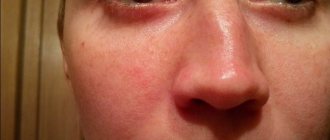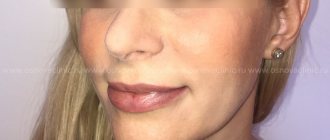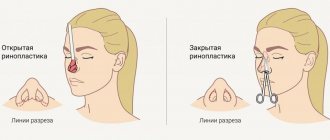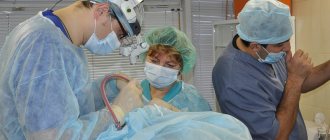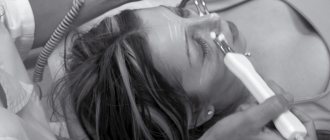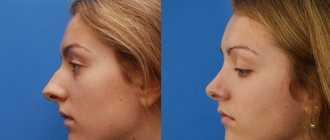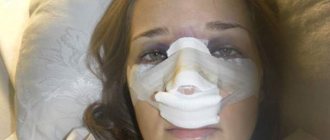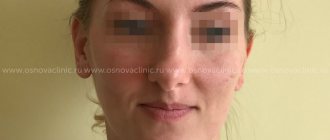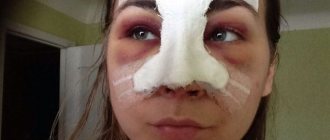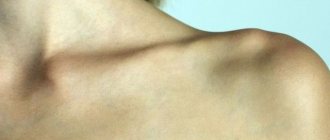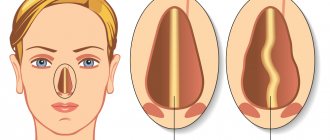Rhinoplasty
– one of the most complex plastic surgeries performed for the purpose of cosmetic correction of the shape of the nose (nose reduction, removal of the nasal hump, correction of curvature, plastic surgery of the tip of the nose, change in shape, etc.), can be combined
with ENT surgery (septoplasty)
.
Combined rhinoplasty and ENT surgery is called rhinoseptoplasty.
In the recent past, rhinoplasty involved breaking the bones of the nose and then creating the desired shape. Today, many plastic surgeons have abandoned such a radical method, since the latter involved serious trauma to tissue, cartilage and bones, as well as low predictability of the result. It is possible that some surgeons still use the described method, so if you want to undergo cosmetic rhinoplasty, it makes sense to clarify all aspects of the future surgical intervention with the surgeon.
Currently, aesthetic correction of the nose involves plastic surgery of the nasal cartilage, bone grinding or osteotomy (controlled intersection of the bone), and implant material is used.
Open and closed rhinoplasty
Access for rhinoplasty can be open (open rhinoplasty)
when the skin part of the nasal septum is cut at its narrowest section, and
closed (closed rhinoplasty)
. The incision lines with a closed approach are located on the mucous membrane in the vestibule of the nose, so the resulting scars are invisible. The plastic surgeon chooses the access, as well as the surgical plan, individually.
Rhinoplasty is considered a traumatic surgical procedure. Surgical trauma is caused by widespread exfoliation of soft tissue in the area of the tip and dorsum of the nose, modeling of bone and osteochondral tissue, their movement, removal or implantation of osteochondral or cartilaginous fragments of the nose. At the end of the operation, a fixing plaster bandage is applied to the nose, and gauze turundas are inserted into the nasal passages.
Open rhinoplasty. Photo:
Closed operation. Photo:
Rhinoplasty surgery using any method (open or closed) is performed under intravenous anesthesia in combination with local anesthesia
(general surgery tests, plus sinus x-rays).
Photos "Before" and "After"
1 month after rhinoseptoplasty
See more “Before” and “After” photos
So, the main indications for nose surgery are:
- disproportion of the length and width of the nose in relation to other elements of the face;
- deformation of the septum;
- deformed osteochondral structure (from birth or acquired);
- asymmetrical nose (hump, different size nostrils, double, downturned or upturned, asymmetrical tip, potato-shaped, and so on);
- the need to correct the unsuccessful outcome of a previous operation, revision rhinoplasty.
Depending on the nuances and type of operation, rhinoplasty helps to achieve the desired effect and, if necessary, restore its functionality.
⇒ INFORMATION: How to get rid of a hump on the nose?
Rhinoplasty result after 2 months
See more “Before” and “After” photos
Types of operations
- Rhinoplasty - aesthetic surgery
- Septoplasty - correction of curvature and necessary functionality (difficulty in breathing, polyps)
- Rhinoseptoplasty is a labor-intensive operation during which both the length, width, height and shape of the nose (including the tip) and the septum are corrected to restore respiratory function.
Preserving closed plastic
See more “Before” and “After” photos
Cost of male rhinoplasty
| Facial plastic surgery - Dr. Lina Alievna Isbir Prices include a promotion with a 50% discount with permission to publish the results of photos and videos | |
| Rhinoplasty of the tip of the nose | 170,000 rubles instead of 340,000 rubles Limited offer |
| Rhinoplasty without osteotomy, category 1 with photo and video resolution of the results of the operation Prices are indicated with a 50% discount | 180,000 rubles instead of 360,000 rubles Limited offer |
| Rhinoplasty without osteotomy, category 2 with photo and video resolution of the results of the operation Prices are indicated with a 50% discount | 190,000 rubles instead of 380,000 rubles Limited offer |
| Rhinoplasty of the tip of the nose with osteotomy of the 1st category with photo and video resolution of the results of the operation Prices are indicated with a 50% discount | 180,000 rubles instead of 360,000 rubles Limited offer |
| Rhinoplasty of the tip of the nose with osteotomy of category 2 with photo and video resolution of the results of the operation Prices are indicated with a 50% discount | 190,000 rubles instead of 380,000 rubles Limited offer |
| Primary rhinoplasty of the nose with osteotomy of category 3 with permission to publish photos/videos before and after surgery Prices are indicated with a 50% discount | 210,000 rubles instead of 420,000 rubles Limited offer |
| Revision rhinoplasty of the nose, category 1, with permission to publish photos/videos before and after surgery. Prices are indicated with a 50% discount. | 200,000 rubles instead of 390,000 rubles Limited offer |
| Revision rhinoplasty of the nose category 2 with permission to publish photos/videos before and after surgery Prices are indicated with a 50% discount | 210,000 rubles instead of 420,000 rubles Limited offer |
| Repeated rhinoplasty of the nose, category 3, by Dr. Lina Isbir with permission to publish photos/videos before and after the operation Prices are indicated with a 50% discount | 220,000 rubles instead of 440,000 rubles Limited offer |
| Repeated rhinoplasty of the nose of the 1st category with the collection of costal cartilage from Dr. Lina Isbir with permission to publish photos/videos before and after the operation Prices are indicated with a 50% discount | 260,000 rubles instead of 520,000 rubles Limited offer |
| Repeated rhinoplasty of the nose of the 2nd category with the collection of costal cartilage from Dr. Lina Isbir with permission to publish photos/videos before and after the operation Prices are indicated with a 50% discount | 290,000 rubles instead of 580,000 rubles Limited offer |
| Tertiary rhinoplasty with nasal reconstruction (1st degree) | 360,000 rubles instead of 720,000 rubles |
| Tertiary rhinoplasty with nasal reconstruction (grade 2) | 420,000 rubles instead of 830,000 rubles |
Expand
Sign up for a consultation
The structure of the male nose
Preparation for rhinoplasty
During a face-to-face consultation, the doctor examines the patient, draws up a plan for preparing and performing nose surgery, and explains all the subtleties of rhinoplasty that may arise.
Then it is possible to perform modeling on a computer: using a photograph of the patient, the specialist creates an image of the final result of the operation. After approval, the doctor prescribes a preoperative examination and a date for rhinoplasty.
Analyzes
- Blood tests – 14 days before surgery.
- Complete blood count with leukocyte formula (hemoglobin, red blood cells, leukocyte formula, platelets, ESR)
- Biochemical blood test (total and direct bilirubin, amylase, AST, ALT, urea, creatinine, glucose, potassium, sodium, chlorine)
- Coagulogram
- Markers of hepatitis B and C (HCV), HIV (HBV), syphilis (RW) – 1 month before surgery.
- Blood type, Rh factor – indefinitely.
- ECG (electrocardiogram) with interpretation – 14 days before surgery.
- If necessary, computed tomography of the paranasal sinuses.
- Ultrasound of the veins of the lower extremities with a phlebologist’s report - 1 month.
- Fluorography - 1 year.
- The therapist's conclusion.
A month before rhinoplasty, you should not take any medications without consulting your doctor: some of them may interact with drugs used for anesthesia.
4 weeks before and after plastic surgery (unless the doctor prescribes a longer period), you should refrain from smoking.
⇒ INFORMATION: Is it possible to fix your nose with a “potato”?
Correction of the hump and tip of the nose
Indications
Rhinoplasty can solve both medical and aesthetic problems of the patient. Most often, men turn to surgeons with medical problems, such as the consequences of injuries and a deviated septum. Less often, men are bothered by a hump, an overly large nose, a saddle-shaped or too wide back. Indications for rhinoplasty include:
- difficulty breathing or lack of it;
- congenital or acquired curvatures of the nose and nasal septum;
- deformation of the nasal bone;
- burns;
- frostbite;
- presence of a hump;
- excessively large/small distance between the nose and upper lip;
- non-standard shape of the tip, bridge of the nose, bridge of the nose;
- changes in the size and shape of the nostrils or the entire nose.
Postoperative period
The duration of plastic surgery is usually 2 or more hours.
At the end of the plastic surgery, a tight bandage is applied to the nose, which should be worn for 7-10 days. The person spends the first 1-2 days in the hospital, then the doctor discharges him home.
During the healing period, the doctor monitors the patient. It is necessary to attend regular examinations, and if any questions arise, they are quickly resolved with the doctor over the phone or during an examination.
The duration of the healing period after rhinoplasty depends largely on the characteristics of the human body, as well as on his age, which means that the doctor can only tell the approximate duration of rehabilitation.
After plastic surgery, you should not exercise for a period of 4 to 8 weeks, and you should not be exposed to extreme temperature changes. In addition, after the intervention, the doctor will provide more specific instructions regarding diet and daily routine.
⇒ INFORMATION: Attitudes towards rhinoplasty in different countries of the world
Rhinoplasty at the clinic of Vladimir Kosinets
Each individual situation is unique and requires the exceptional professionalism of the surgeon and his precise knowledge of the anatomy of the nose, as well as the properties of tissues and skin.
Rhinoplasty is one of the most frequently performed procedures in Russia. The high degree of professionalism of the doctor and innovative equipment make it possible to successfully carry out even the most labor-intensive plastic and reconstructive manipulations, while minimizing tissue trauma.
Vladimir Aleksandrovich Kosinets has performed hundreds of successful operations, his professionalism and experience allows him to achieve success in most cases. Vladimir Kosinets is a doctor of the highest category, Doctor of Science in Medicine, Professor. Work experience in the field of surgery is over 13 years. For many years, he has successfully combined complex aesthetic and reconstructive operations with scientific activities. In the field of rhinoplasty, he performs both direct correction of the nose and the septum, improving both the aesthetic aspect and the functions of the nose.
Rhinoplasty and the formation of harmonious facial features are one of the main directions in the work of the best surgeon Vladimir Kosinets, and the rhinoplasty performed by him is deservedly among the best. As the aesthetic surgeon himself says, he considers his main task to be to make the patient beautiful so that traces of plastic surgery are invisible.
Methods of execution
Based on the methods used, nose correction is divided into 2 types:
- Closed - incisions are made inside the nostrils
- Open - incisions are made inside the nose and in the middle of the nostrils, which is called the columella
⇒ INFORMATION: Open and closed rhinoplasty: differences and features
Revision rhinoplasty
Rhinoplasty occupies one of the first places among types of plastic surgery in terms of repeated requests from patients with a request to correct the results of the first operation. This is not always due to mistakes made by doctors who performed primary rhinoplasty. Sometimes a person, having received a “new” nose, realizes that he would like to have a different shape.
It is important to note that if the operation is unsuccessful, then a repeat operation (correction) can only be performed after 6-8 months. This is due to the fact that a sufficient number of subcutaneous scars should form in the area of surgical intervention, which will eliminate the “empty nose” effect during subsequent plastic surgery. It should be said right away that secondary rhinoplasty is a more complex operation. The resulting scars have to be excised again. It takes great skill from the surgeon to shape the nose beautifully and symmetrically.
Conditions for rhinoplasty surgery
Rhinoplasty can be performed after the patient reaches 18 years of age, when the facial skeleton completes its formation. However, many rhinoplasty surgeons believe that rhinoplasty is best performed after reaching 22 years of age.
Features of the recovery period and possible complications after rhinoplasty
After rhinoplasty, the patient spends 1-2 days in the hospital.
On days 2-3, gauze turundas are removed from the nasal sinuses. The plaster is removed after 10-14 days. The swelling goes away after about 1 month, but complete “shrinkage” of the nose occurs in at least six months. Rhinoplasty is accompanied by natural changes in the correction areas. Inevitable surgical trauma to tissues with disruption of the integrity of blood vessels leads to hemorrhages in the skin of the nose, eyelids, infraorbital areas and eyes, which persist for 2-3 weeks. As a rule, swelling and lymphostasis of the soft tissues of the nose persist for a long time, up to 4-6 months, and sometimes up to a year.
After rhinoplasty, early postoperative complications are possible: bleeding, hematoma, inflammation and others. Bleeding and hematoma can develop after extensive rhinoplasty or the patient's disruption of the postoperative regimen and sometimes require emergency surgical intervention. To prevent complications after surgery, cold is used locally for the first 4 hours, hemostatic, anti-inflammatory and antibacterial therapy is prescribed. For the first 24 hours, the patient should remain rested and in bed. The dressing is done the next day after the operation.
During this postoperative period, it is necessary to follow all the instructions of the attending physician and attend dressing changes.
The following recommendations must be followed for at least 2 months:
- Maintain a gentle regime that excludes the intake of solid foods (crackers, nuts, dried fruits, etc.), carbonated drinks, sports, physical activity associated with lifting weights, injuries, taking a hot bath, visiting a bathhouse, sauna; hair should be dried only with cool air , limit sexual relations.
- Follow a water-salt diet in the form of: excluding “spicy” foods, foods high in salt and drinking liquid 3 hours before bedtime.
- Use ointments, medications and physiotherapeutic procedures only after prescription by the attending physician.
- You can wash your hair for the first time after surgery after consulting with your doctor.
- During the first year, dynamic observation by the attending physician is required once a month or agreed upon individually.
Patients undergoing rhinoplasty need to know:
- About the long (from 1 to 1.5 years) recovery period after rhinoplasty.
- That during the recovery period there may be temporary changes in the shape and function of the nose: impaired nasal breathing in the form of nasal “stuffiness” especially in hot, dry and cold damp weather, decreased sensitivity of nasal tissue, thickening of the contours of the back and tip of the nose, curvature, unevenness of the skin resulting from the active formation of subcutaneous scars. The exact characteristics of these scars cannot be clearly determined before surgery due to the individual characteristics of scarring processes. Such changes require timely consultation with a doctor for additional medication, physiotherapeutic, x-ray treatment, and sometimes re-correction.
The concept of rhinoplasty by V. Kosinets
From a geometric point of view, the nose is a complex polygon. There is no single universal method of rhinoplasty that would equally satisfactorily solve the problems of various forms and deviations. In his practice, Vladimir Aleksandrovich adheres to two surgical techniques when working with the external nose - structural and conservation rhinoplasty.
Structural rhinoplasty
The essence of structural plastic surgery is to change the nasal bones by excision. That is, in order to achieve a beautiful curve of the back, to narrow it, the doctor cuts through the bones (osteotomy). These manipulations allow you to achieve high aesthetic results when working with the complex bridge of the nose. Complex bones include bone frames that have previously been subjected to trauma, impact, or surgery.
Structural rhinoplasty can be performed either closed or open.
Who is it suitable for?
Structural rhinoplasty is suitable for those patients who have a history of trauma or have previously had a nose job.
⇒ INFORMATION: Rhinoplasty - get rid of annoying snoring
FAQ:
Is it possible to change only the tip of the nose (raise it, or make it narrower) separately from the other “parts” of the nose?
Yes, it is indeed possible to change the tip of the nose separately from other “parts” of the nose. But this is only feasible if the back of the bow is “good” - not high, in other words, if you look in profile, the back does not have a large “sail”.
Are patients who come for rhinoplasty of the tip of the nose most often those who have never had rhinoplasty, or have the majority already had this operation and their tip has drooped?
In our practice, there are both cases. Some have never had rhinoplasty, and we see that the problem can be solved not with classical surgery, but with plastic surgery of the tip of the nose only. But there are also patients who have already had rhinoplasty previously, and they only want to raise the tip, which has sank over time.
Is it true that after rhinoplasty the tip of the nose always droops? Or is this a myth?
No, this is not a myth. The tip of the nose can indeed droop over time, and we have such patients. And in most cases, surgery on the tip of the nose gives an excellent aesthetic result; this small correction completely changes the patient’s appearance.
If a patient comes in with a problem of a drooping tip, is it possible to lift it once and for all?
In any case, the tip of the nose drops to a certain extent, so when we perform the operation, we lift it a little more than necessary. This is called overcorrection. Therefore, at first the tip of the nose may be raised a little, taking into account the fact that when it goes down, it will be at the level it needs to be.
Conservation rhinoplasty
This type of correction (from English Preservation rhinoplasty) refers to innovative methods of aesthetic surgery on the nose. The name says it all: more delicate handling of tissues, a minimum of resections, preservation of the integrity of anatomical structures - all this leads to a more predictable result.
During conservation rhinoplasty, the doctor practically does not excise the bone component of the nasal dorsum. Excess parts of cartilage and bone are removed only from some parts of the nose, making it possible to later press the back inward.
Conservation rhinoplasty is always performed in a closed manner.
Who is it suitable for?
This technique is suitable for patients without injuries or previous aesthetic corrections of the nose. This method is perfect for primary correction.
It is important to note that conservation rhinoplasty allows you to achieve excellent results even if you have a nasal hump.
⇒ INFORMATION: What absolutely should not be done after rhinoplasty
Plastic results
With the help of correction, the tip of the nose can be made narrower, more defined, and also raised. Moreover, you can raise the tip of the nose provided that the bridge of the nose is low. Since simply narrowing in such a situation will not give anything. Quite often, patients with a high back come to us and want to lift the drooping tip of the nose, but in this case, plastic surgery of only the tip of the nose will only visually increase the “sail”. Therefore, the approach to aesthetic correction should be comprehensive.
Rehabilitation period
After the operation, the patient is given a plaster cast for 5-7 days. After its removal, swelling will persist for some time (up to 1 month), but it will be insignificant. For 1.5 months, restrictions on physical activity (sports, fitness), warming procedures (baths, saunas, solarium) are prescribed. For the first month, sleep only on your back.
Most popular questions
- What tests should you take when planning to have plastic surgery?
Usually these are blood and urine tests, ECG, fluorography, computed tomography of the nose. The doctor will provide an exact list of tests during the consultation.
- At what age is it permissible to perform correction?
The patient must be at least 18 years old.
- What anesthesia is used for rhinoplasty?
General anesthesia is used.
- After how many days are the plaster and stitches removed?
The plaster, or splint, is removed after about 9-10 days. Sutures (in case of correction of the nostrils) are removed 7-9 days after the intervention.
- How long does it take for the swelling to go down?
External swelling disappears after approximately 3 weeks. The rehabilitation period is different for each patient; usually the nose heals within 8-16 months.
Rehabilitation period after rhinoplasty of a nose with thick skin
Rehabilitation of patients with thick nasal skin takes longer than for patients with standard skin characteristics. This is due to the longer process of tissue regeneration and the tendency of the skin to scar. To ensure a speedy recovery and achieve the best possible result, the patient must follow the doctor’s instructions:
- do not remove the turundas before the due date, do not touch them with your hands;
- do not remove the plaster cast for the first few days;
- take antibiotics prescribed by your doctor;
- do not wear glasses for a month;
- eliminate excessive physical activity;
- refuse salon cosmetic procedures;
- do not sleep face down;
- Avoid direct sunlight, avoid visiting solariums, baths and saunas for three months.
